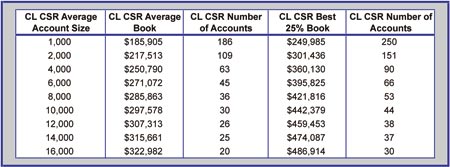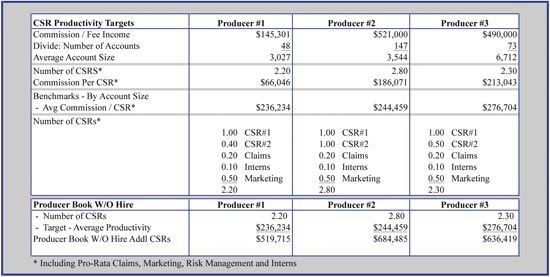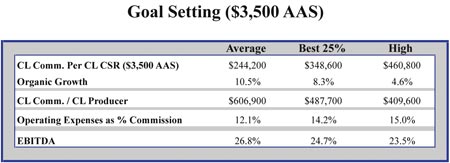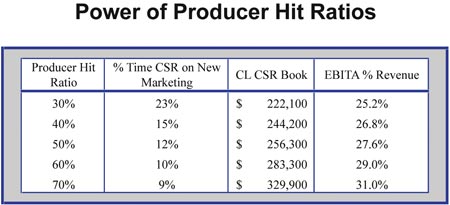|
Building Equity Value Driving organic growth through service staff management Complaints by overworked CSRs should prompt detailed analysis of sales & service functions By Chris Darst Are you frustrated because your agency’s organic growth is too slow? Are you critical of your production staff because they have smaller than average books of business and are not generating enough new business activity to out-run the soft market? Do these same producers complain that they just don’t have enough time to manage their books and also drive new business production? Does your service staff complain about workload and encourage you to hire more staff? If this describes your agency, your frustration is understandable. If it is any consolation, you are not alone. In this column we will examine the interrelationship between the production staff and service staff. To do so, we will use Marsh, Berry & Co. statistics on agency productivity drawn from our database of agencies we work with. We hope this will provide insights that will help you position your agency for increased organic growth and ultimately agency value. Goal setting The first step in managing the service staff within an agency is setting goals and objectives. It is amazing how few agencies have quantifiable workload goals for individual customer service representatives (CSRs) or servicing teams. Without using some kind of metric as a measuring stick, it is impossible to determine whether you are making forward progress. CSRs within this article are defined as any employee who helps service client relationships such as commercial lines (CL) customer service representatives, CL customer service assistants, CL account managers, CL account executives, CL claims personnel (or a pro-rated allocation of the portion of their time devoted to commercial lines claims), marketing personnel, and service managers. We are not including producers or support personnel (i.e., accounting, file clerk, bookkeeper, receptionist). Assume that one of your service teams has CL commissions per CSR of $300,000 and another team is operating at a workload of $220,000. It would be easy to assume that the first team is out-performing the second. What may be shocking to some is that commission dollars alone do not shed any light on the relative productivity of the two producer teams and definitely should not be the basis for setting workload targets. A far more relevant approach would be to compare each producer team within your agency to others within the industry that write accounts of a similar size. A service team that writes larger accounts by design will handle fewer accounts but a greater volume of commission income. To set productivity benchmarks for your service staff, make sure that you are setting workload goals based on the size of the accounts being handled. To illustrate this point, assume that the first service team that is achieving the workload of $300,000 has an average account size of $12,000 and the team with $220,000 in workload has an average account size of $1,000. Which team is more productive? In this situation, the service team that is handling $300,000 in commission with an average account size of $12,000 is slightly below average. The other team is close to the top quartile in the entire industry. The chart in Figure 1 illustrates the relationship between an agency’s average CL CSR account size and average CL CSR book size.
Absent metrics, many service teams report that they are overworked and that the agency should hire more support. After running the numbers, owners are often shocked that the noise is often the loudest from teams that are the least productive. Before hiring another employee, calculate the productivity of your service staff based on book size and average account size. Once the baseline is established, targets can be set for the service teams that compare your agency to your peers. To establish book of business goals for service teams, you will probably need to allocate employees based on their respective roles within the organization. To illustrate this process, assume that your agency has three producers (see Figure 2 with Producer #1, Producer #2 and Producer #3). Producer #2 has a $521,000 book of business and an average account size of $3,544. The total number of service employees on this team is 2.8. Thus, they handle $186,071 in commissions per CSR. Based on the size of the accounts handled by the team, workload would need to be 30% more for this team to be average ($244,459). Stated another way, Producer #2 needs to grow his book of business to $684,500 ($244,459 x 2.8 employees) before another employee is hired or allocated to Producer #2.
Organic growth When setting productivity goals for the service staff, it is important to understand that it may be better to be “average” than “better than average.” If the workload of the service staff is too high, the service staff will have little to no time to support the producers and in many cases will actually delegate servicing workload back to the producers. In fact, agencies with above average commercial lines CSR productivity have lower organic growth rates than agencies with average CSR productivity. To illustrate this point, we conducted research that correlated organic growt, to CL commission per CSR where the average account size totaled $3,500. Figure 3 is a chart that compares and contrasts organic growth and producer book size in cases where productivity is average, best 25% or the highest performer within our database.
Often, when CSR productivity numbers are the highest, producers are spending too much time servicing existing books and not enough time generating new business. While we do not want to discount the importance of service and retention, agencies need to establish an operating structure where both retention and new business are maximized. When comparing one agency to another, the day-to-day responsibilities of the CSRs vary considerably. In most agencies, the responsibility of the service staff is limited to clerical functions (updating client records and filing paperwork) and administrative servicing activities such as checking policies, processing changes, and invoicing customers, etc. In high growth agencies, the service staff relieves the production staff of most of the account management activities. The service staffs within high organic growth agencies prepare market submissions, negotiate carrier pricing, generate prospect proposals, develop and manage service timelines, conduct workflow audits to improve retention, generate detailed stewardship reports and function as an account executive to manage accounts on behalf of producers. These CSRs may have lower statistical productivity, but the byproduct is utopia; producers have the time to drive new business production and are capable of maintaining larger than average books of business. Profit leverage It is common in our industry for agency owners to focus on either growth or profit, but rarely do we see agencies executing on both. It is not unusual to hear that profits have been minimal over the last few years because the agency is currently in what they call “growth mode.” The opposite is also true. Agencies preparing for a sale often indicate that growth has been stagnant because of a focus on improving profitability to receive a maximum price. Agency value is maximized when you can drive both growth and profitability. Is it possible to maintain a sophisticated professional service staff and drive a strong profit margin? Absolutely. Where organic growth is strongest, producers have the largest books. Additionally, those agencies with a more professional service staff and higher organic growth had lower operating expenses and, in turn, higher profitability as measured by EBITDA (Earnings Before Interest, Taxes, Depreciation, and Amortization). The results are illustrated in the chart below (Figure 4).
To maximize growth and profitability, should you expect and accept average productivity from your service staff? The answer is no. Few agencies can accomplish high productivity and strong organic growth—but it can be done. CSR productivity leads to growth and profitability One area that management should focus on to improve the productivity of the service department is the hit ratio on new business. The service staff within agencies where the producers have low hit ratios spend an inordinate amount of time quoting, proposing, and working to process business that the agency never writes. Our research indicates that within agencies that have a 30% producer hit ratio, the service staff spends 23% of their time dedicated to working on new business marketing. When the producer hit ratio reaches 60%, the agency requires fewer servicing personnel to manage the quoting machine. The result is higher profitability. If you can improve the producer hit ratio within your agency, service staff productivity will improve as the percentage of time wasted on marketing accounts that are never written will decline. Agencies with strong organic growth have implemented a sales management system that requires producers to concretely demonstrate that the agency has a high likelihood of converting an account before management will allow service staff to work on a new piece of business. Figure 5, examines the relationship between the producer hit ratio, the amount of time CSRs spend marketing, CL CSR book size, and EBITDA.
A second area management should focus on to improve the productivity of the service department is the retention ratio on the existing book of business. Most high-performing agencies have procedures to ensure low E&O claims and high retention. Agencies with strong organic growth require a completed service timeline for each commercial account. These agencies also set up activities within the agency management system that tie individuals within the service team to commitments made to the insured that were captured and communicated to the customer in the service timeline. Agencies with strong retention conduct quarterly workflow audits generating exception reports from the agency management system to identify where activities have not been completed as promised. Such leading agencies then use this information as part of the individual review process for the members of the service staff, including compensation adjustments and bonus incentives. Service staff management is a vital component for driving agency value. Agency managers need to first understand agency CSR productivity metrics and then establish productivity targets for the CSR staff. By increasing both the agency’s new business hit ratio as well as the retention ratio on renewal business, service productivity will increase, thus driving the organic growth and value of your agency. * The author |
||||||||||
|







